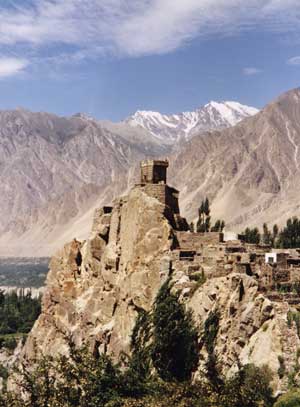 |
Altit Fort in HunzaAltit fort is situated in the village of Altit about three kilometers from Karimbabd. It has been built on a sheer rock cliff that falls 300 meters (1,000 feet) into the Indus river. The fort is a 100 years older than the Baltit Fort and was at one time inhabited by the ruling family.
Baltit FortAward of Excellence Baltit Fort, Karimabad, Hunza Valley, PakistanThe restoration of the majestic 700-year-old Baltit Fort exemplifies excellence in conservation practice applied to large-scale monuments. This challenging project was the first of its kind in northern Hunza. By demonstrating that historic structures can be saved, restored and recycled for continued use in the community, the Baltit Fort project is a model for the revitalization of historic structures throughout the northern regions of Pakistan. In this project, the historic wood and masonry structure was carefully repaired using a combination of traditional local knowledge and state-of-the-art conservation techniques. The fort's restoration has fostered the local revival of traditional building trades, while an associated handicrafts project provides improved livelihood opportunities in the area. In its new use as a cultural centre and museum, the Baltit Fort attracts thousands of visitors to the province and has contributed to reinvigorating the local community's pride in their heritage.HISTORICAL SITES Baltit FortBaltit Fort breaks the monotony of mud-rock houses of Hunzakuts. It is situated on the top of a hill from where it overlooks the whole valley. The fort was built some 600 years ago. It is entirely made of stones, supported by timber beams and plastered over with sun-dried mud. Elders of Hunza tell that a Balti princess was married with the Mir of Hunza. She brought Balti masons and artisans to build this fort as a dowry item. The fort remained the palace and family home of the Mirs until 1960 when a witch came to reside in it. The royal family shifted to a new granite palace. The fort has been well kept. It maintains a museum, library and a nice restaurant. The credit goes to the Agha Khan Trust for Culture. Baltit Fort is three-storey building with 53 rooms. The main gate opens into a dark hall or corridor on the ground floor. There are guest rooms, kitchens, storerooms, prisons and living rooms attached to this corridor. A wooden staircase goes up through a square opening in the floor above. The second floor has family apartments, reception rooms, royal court, arms depot and guards' chambers. A balcony presents a fascinating view of the valley. Another ladder takes to the roof. This is the best spot to view the famous peak of Rakaposhi that rises straight out of cultivated fields and reaches 7788 meters in the sky. Behind the fort, the Karakoram rises in a series of needle-sharp peaks. The most famous of them is lady's finger. Locals also call it Bulbuli's peak, after a legendary Hunza princess. The peak is so steep that even snow cannot sustain on its top. Thus, the black peak stands in contrast with its snow covered neighbors. Altit Fort Altit Fort hovers on a rocky cliff with a 300 meters deep plunge into the Hunza River. The fort resembles Baltit Fort in its construction. The main entrance leads to the ground floor. It has a few storerooms, dark and sinister. A trapdoor leads to basement. Here a former Mir murdered his brothers to capture the throne. The basement was also used to keep prisoners who were later thrown out into the river. The second floor consists of family apartments and royal court, kitchen and bathroom. A staircase leads to the roof. There stands a watchtower with beautifully carved doors and windows. The tower was made in 1503 A.D. To the right of the tower is an ammunition depot and to the left is a small mosque. The fort has mysterious and awful environment. A similar compound of a fort, watchtower and mosque is situated in Ganesh village. Its history is not known. Another worth visiting site is the sacred rock of Ganesh.
|

